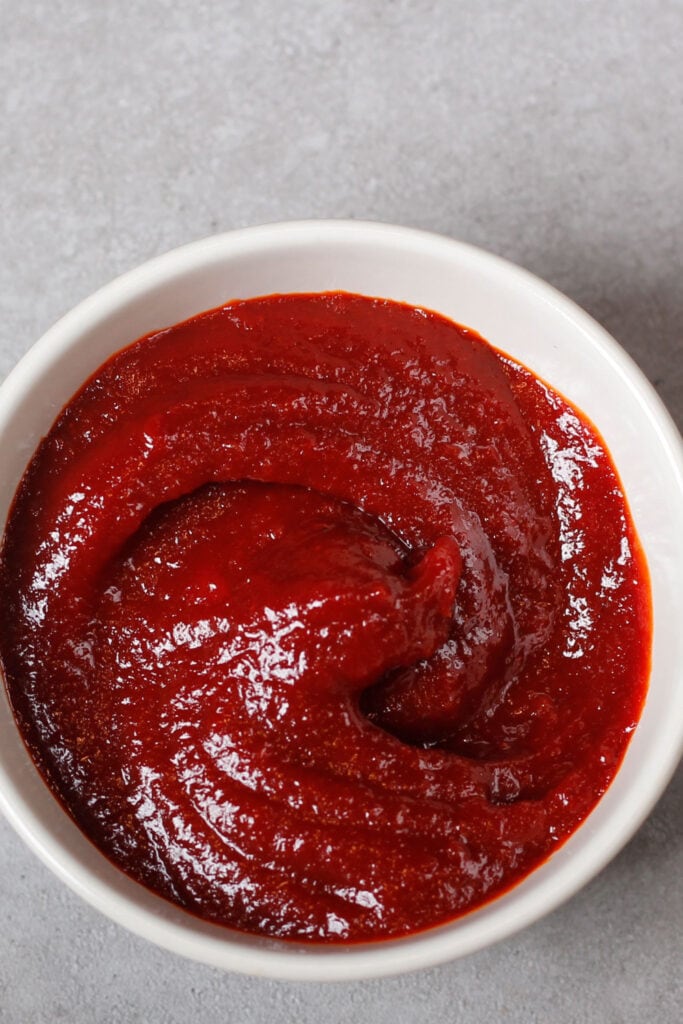These popular Asian sauces are a fantastic way to add a little extra flavor to your food.
From tasty marinades and yummy dips to drool-worthy dressings, you’ll love them all.

Whether you opt for something store-bought or go the homemade route, you really can’t beat Asian sauces in terms of flavor, texture, and color.
I’m in love with Thai peanut sauce, and my family can’t get enough of anything with gochujang in the mix.
But that’s just the tip of the iceberg!
And since there are so many fun and different Asian sauces to choose from, everyone can find a fave.

1. Hoisin Sauce
Hoisin sauce isn’t as well-known as soy sauce.
However, it’s gained popularity over the last several years because it’s a terrific ‘all-around’ sauce you can use on practically anything.
You can enjoy it as a marinade, dipping sauce, BBQ substitute, and more.
It’s made from fermented soybeans and tastes incredible. It’s a thick, sweet-n-savory sauce that’s similar to barbecue sauce.
Try it the next time you want something different.
You’ll find several recipes online. But since buying a bottle is so inexpensive, I suggest sticking to the ready-made stuff.
2. Tonkatsu Sauce
People love to describe things as ‘quick and easy.’
Even so, it’s hard to find a quicker or easier recipe than tonkatsu sauce.
It uses just four ingredients and takes a mere five minutes to whip up. Just mix ketchup with sugar, Worcestershire, and oyster sauce.
How easy is that?
It’s a sweet, smoky condiment that’s perfect for dipping.

3. Ssamjang
Ssamjang is another five-minute sauce anyone can make. It uses a few more ingredients than tonkatsu sauce, but it’s seriously worth it.
Ssamjang is a famous Korean sauce with a rich depth of bold flavors. It somehow manages to be savory, nutty, salty, and smoky all at once.
It’s thick and chunky, similar to the consistency of salsa. Most people use it for dipping or spreading on top of things.
And while this recipe is great, why make it when the Assi brand is affordable and tastes so good?
4. Teriyaki Sauce
Like soy sauce and hoisin, you can buy teriyaki sauce anywhere. Even in America, it’s as common as mustard or ketchup.
Still, you may run out one day. That’s why it’s good to have a recipe for a homemade version up your sleeve.
This one is my favorite – sweet, sticky, and full of ginger. Delish!
5. Classic Vietnamese Dipping Sauce (Nước Chấm)
Want authentic Vietnamese flavors for dinner? This dipping sauce will do the trick.
It’s perfectly balanced between sweet and tangy, has a lovely appearance, and takes only five minutes to prepare.
Garlic and lime may not seem like they’d be compatible. They really, really are.
You’ll get sweet and umami notes in this one, and it’s the only sauce I use for my spring and egg rolls.

6. Gochujang
Also known as Korean barbecue sauce, gochujang is thick, sweet, smoky, and spicy.
It’s a fantastic substitute for BBQ sauce and has more heat.
Like ssamjang, gochujang has a thick, salsa-like consistency. (Some people compare it to tomato paste.)
It’s well-seasoned and has plenty of red chili flakes. If you like, you could use it for dipping, but it is pretty hot. So, I like to tone it down with a bit of mayo.
7. Filipino Banana Ketchup
The ingredients list for this simple condiment is a little odd.
I mean, in what other recipe would you mix bananas, tomato paste, ginger, brown sugar, and vinegar? (Garlic and cayenne, too!)
It kind of sounds like a disaster waiting to happen, right? Surprisingly, it’s actually quite good.
It’s a little thicker and lumpier than ketchup. Still, its taste is remarkably similar to everyone’s favorite red condiment.
You can use it on anything you’d serve with ketchup.
Or, try adding it to fried rice or your morning eggs. You won’t be sorry you did.
8. Peanut Dipping Sauce
This recipe for peanut dipping sauce is one of the best. It produces delightfully creamy, nutty, and slightly spicy peanut sauce you’ll want to eat with a spoon.
Most people use it as a dipping sauce. (It’s spectacular on raw veggies.)
Personally, though, I like it with grilled chicken and buttered noodles. It gives them a rich, savory flavor that’s impossible not to love.
9. Doubanjiang | Broad Bean Paste
Doubanjiang is a Sichuan staple.
It’s a thick, spicy sauce with just a hint of tang. It’s also chunky, dense, and somewhat sticky.
Use it as a topping for cooked meats, or mix it into your stir fry. Either way, you’ll love it (even if it sets your mouth on fire).
Note: it’s not the easiest sauce to make and requires several ingredients. But if you’re looking for something that tastes like the real thing, this recipe is it.
10. Ponzu Sauce
Ponzu is a bold, citrusy sauce that needs no introduction.
You’ll know exactly what I mean if you’ve ever tried it. It’s not a condiment you’ll soon forget.
It has a robust, refreshing flavor that works well for dipping, marinades, or stir fry.
But you can use it however you like since it tastes great in everything.
It only calls for six ingredients, but it takes at least a day or more to make. It needs plenty of time to chill in the fridge, so be sure to plan ahead.
(Kikkoman also has a delicious ponzu if you don’t want to wait.)
11. Tamarind Sauce
Most tamarind sauces are a bit on the sweet side, but this one isn’t. That’s why I prefer to use this recipe than to buy it ready-made.
This one is tart and tangy with a bit of heat to round out the flavor.
It’s a thick sauce that looks almost like jelly or jam. (My gramma compares it to apple butter.)
Fortunately, the taste isn’t nearly as sweet as any of those things.
Tamarind sauce makes an excellent chutney. You could also add it to soups, stir-fries, or pad Thai.
I’ve even known people to use it as a meat marinade. So it’s super versatile!
12. General Tso Sauce
Most of us have enjoyed a plate of General Tso’s chicken at some point. If you have, you’re likely familiar with General Tso sauce.
It’s sticky sweet but still spicy and savory. It combines both hoisin and soy sauces for a robust flavor.
Then, you’ll add other seasonings, like ginger, garlic, red pepper, and more.
It’s a one-of-a-kind sauce nearly everyone knows and loves. Now, you can make it for yourself.

13. Fish Sauce
There aren’t many Asian meals that don’t include fish sauce. It’s the mayonnaise of Asian cuisine.
Even if you don’t know it’s there, it probably is.
Of course, some Asian meals don’t have fish sauce in them. They likely have a condiment made with fish sauce, though.
It’s a salty, umami-packed delight, usually containing garlic and lime.
By itself or used to make another sauce, it’s phenomenal. That’s probably why it’s in so much stuff.











